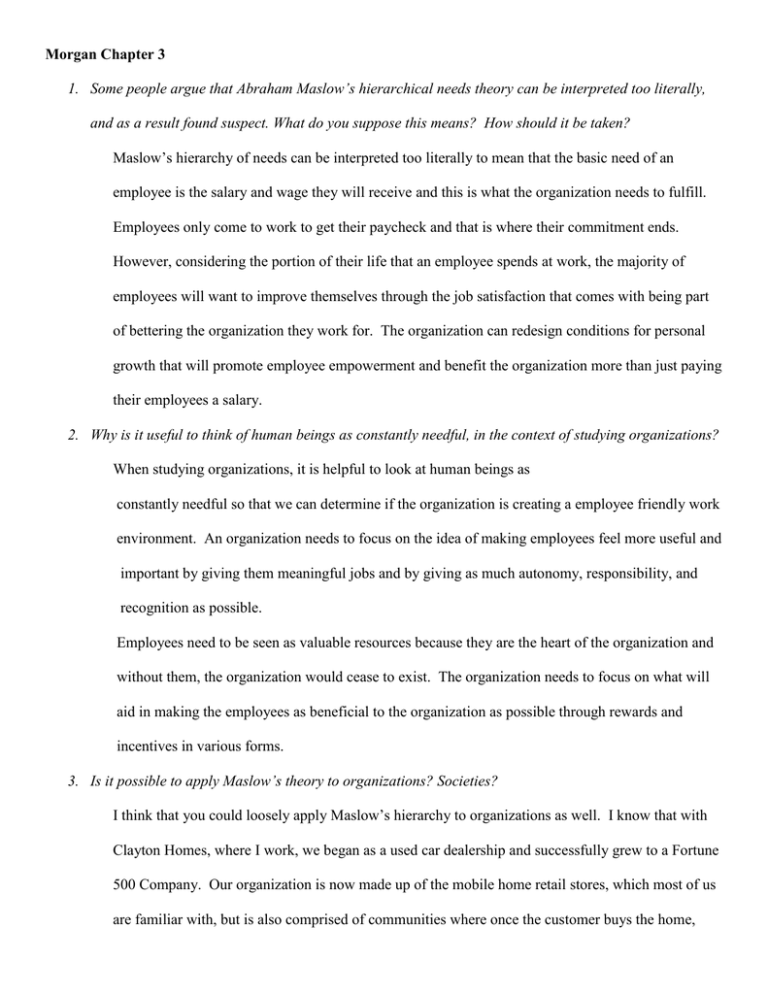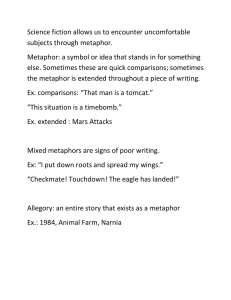Morgan Chapter 3
advertisement

Morgan Chapter 3 1. Some people argue that Abraham Maslow’s hierarchical needs theory can be interpreted too literally, and as a result found suspect. What do you suppose this means? How should it be taken? Maslow’s hierarchy of needs can be interpreted too literally to mean that the basic need of an employee is the salary and wage they will receive and this is what the organization needs to fulfill. Employees only come to work to get their paycheck and that is where their commitment ends. However, considering the portion of their life that an employee spends at work, the majority of employees will want to improve themselves through the job satisfaction that comes with being part of bettering the organization they work for. The organization can redesign conditions for personal growth that will promote employee empowerment and benefit the organization more than just paying their employees a salary. 2. Why is it useful to think of human beings as constantly needful, in the context of studying organizations? When studying organizations, it is helpful to look at human beings as constantly needful so that we can determine if the organization is creating a employee friendly work environment. An organization needs to focus on the idea of making employees feel more useful and important by giving them meaningful jobs and by giving as much autonomy, responsibility, and recognition as possible. Employees need to be seen as valuable resources because they are the heart of the organization and without them, the organization would cease to exist. The organization needs to focus on what will aid in making the employees as beneficial to the organization as possible through rewards and incentives in various forms. 3. Is it possible to apply Maslow’s theory to organizations? Societies? I think that you could loosely apply Maslow’s hierarchy to organizations as well. I know that with Clayton Homes, where I work, we began as a used car dealership and successfully grew to a Fortune 500 Company. Our organization is now made up of the mobile home retail stores, which most of us are familiar with, but is also comprised of communities where once the customer buys the home, they have a place to put it. We have our own financing through Vanderbilt Mortgage, our own insurance, and of course, manufacturing where all of the homes are made. Once the company reached this billion dollar level, it was not enough. We then worked to be the best we could be and were named Manufacturer of the Year – which could be classified as the self-actualization level. I don’t think that we are done striving for better things, though. I think that any firm, in order to compete, has to follow some form of using this ladder to improve the way their organization is run. I think that it is useful to apply Maslow’s theory to organizations, but would not suggest using it as law on the way that employees behave. It suggests a whole range of motivational levels that can be used to inspire an employee to be productive. By varying the means of motivation, the organization finds mutual benefit through employee input and commitment without additional expenditures. I think that the same theory holds true for societies. Without spending extra money, we can form non-profit groups or organizations that have the sole purpose to help the community, state, or nation. By giving them a sense of purpose and sense of belonging, many great things can be done without paying great sums. I am thinking of all the many volunteers in the great charities or non-profit organizations that are motivated by the self-fulfillment of helping out another and feeling a great sense of achievement. Societies can definitely use this theory to organize great associations. 4. What are the liabilities of using such relative terms as mechanistic and organic to describe organizational structures? (pg 46-47) When change in the environment becomes the order of the day, open and flexible styles of organization and management are required. Different types of organizations encounter different rates and levels of environmental change. If an environment is stable, the firm can use a mechanistic - highly structured straight-laced type of management where there is one solution for every problem. However, as with the example in the book of the rayon mill, because they were so extremely structured, they restrained sales volume as to not interrupt the daily flow, thus “shooting themselves in the heel” as far as maximizing profits. If an environment is uncertain and turbulent, the firm would use a more organic or flexible structure that could efficiently keep up with the changing environment. In fact, in this sort of environment, as is common in the technology industries, it is more prevalent that the firm forecast what will evolve before it happens so that it can keep up and stay new and innovative in a vastly competitive market. The liability in using such terms is that the firms are not restricted to fit into any of these categories. There should be times when the firm needs to function “by the book” yet other times when the firm needs to be innovative and stay competitive in order to survive. In fact, the book states, “an effective organization depends on achieving a balance or compatibility between strategy, structure, technology, the commitments and needs of people, and the external environment”. 5. Discuss the strengths and weaknesses of the organization as organism metaphor. Strengths: 1. Develop an understanding between organizations and their environments. It describes the organization as existing in an open system where the environment has a great impact on the way the organization is run. 2. The management of organizations can often be improved through systematic attention to the “needs” that must be satisfied if the organization is to survive. It emphasizes survival as the main task facing any organization which helps the goals to not be ends in themselves, but mediums to survival. 3. The focus on “needs” encourages us to see organizations as interacting processes that have to be balanced internally as well as in relation to the environment. Strategy, structure, technology, human, and managerial dimensions are subsystems with living needs that must be satisfied in a mutually beneficial way. 4. In identifying different “species” of organization, we are alerted to the fact that in organizing we always have a range of options. Matrix, team-based, organic are all forms of solutions we can use to combat a specific hurdle. 5. The metaphor stresses the virtue of organic forms of organization in the process of innovation. The chapter argues that if innovation is a priority, then flexible, dynamic, project-oriented matrix or organic forms of organization will be superior to the mechanistic-bureaucratic. Weaknesses: 1. The rise in importance of the organismic metaphor is a product of changing times that has undermined the efficiency of bureaucratic organizations. 2. The metaphor leads us to view organizations and their environments in a way that is far too concrete. Nature presents itself as being objective and real in every aspect. However, this image breaks down when applied to society and organization because organizations and their environments can be understood as socially constructed phenomena. Their shape and structure is much more fragile and tentative than the material structure of an organism. 3. It is misleading to suggest that organizations need to “adapt” to their environment or that environments “select” the organizations that are to survive. On the contrary, organizations have a choice as to whether they are to compete or collaborate. Collaborating organizations actions can have an impact on the environment. 4. The metaphor also assumes “functional unity” – interdependence where every element of the system works for all the other elements. The different elements of an organization are usually capable of living separate lives and often do so. 5. It encourages us to believe that the unity and harmony characteristic of organisms can be achieved in organizational life. However, in organizations, self-interest is a major conflict. 6. The danger of the metaphor becoming an ideology. When we take the parallels between nature and society too seriously we fail to see that human beings have a large measure of influence and choice over what their world can be. 6. Is it possible an organization totally aligned (strategically, technologically, culturally, structurally, and managerially) with its environment could fail? It is always possible for an organization to fail. Even when the organization appears to be totally aligned with the environment, it is possible for the environment to change, and the organization may not be adapt to change as quickly as the environment is moving. 7. Is it possible to have a company that is too democratic, organic, self-actualizing oriented, complex in its roles, and proactive, for its environment? It is possible for a company to be too much of any of the adjectives listed above. Some environments are completely stable. The best way to survive in this type of environment would be to be more mechanistic in order to maximize efficiency. Stable environments usually have great competition, which forces prices to a minimum. The organization must be efficient in order to make a profit. Being too proactive in this environment might be too risky. 8. What does it mean to say that the population ecology model may be a little too deterministic? According to the population ecology model, if we accept at face value the theory that environments select organizations for survival, then in the long run it doesn’t matter what we do, our destiny has already been chosen for us. Population ecology has downplayed the importance of the choice of strategic direction for an organization - which is so critical. Even if an organization is not the best fit to survive an environment, it is possible for the organization to transform itself from one kind of organization into a more profitable one. Take for example Federal Express. With the technological advances in emailing, many of the contracts and documents that had to be shipped Fed Ex are now being transferred instantaneously over the web. 9. What does it mean to say that organizations and their environments are involved in co-creation, as is said by those who espouse organizational ecology? Environments are involved in co-creation meaning they help produce each other. Organizational environments are composed of other organizations. They are able to influence the nature of their environment. They play an active role in shaping their future when teaming with other organizations. It is sometimes more beneficial for organizations to collaborate as opposed to compete. We have seen oil prices rise tremendously this summer due to the fact that no competition is present. So instead of competition forcing the price down, collaboration has caused the price to skyrocket.

